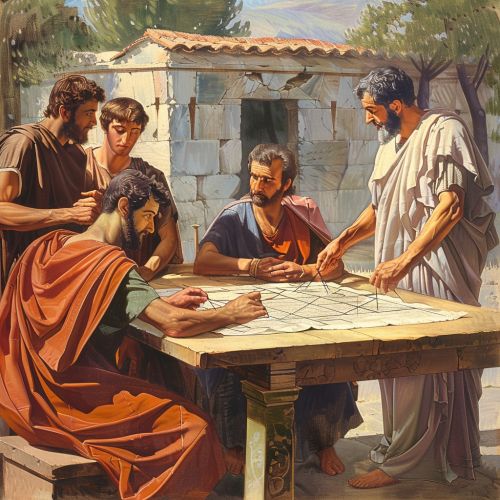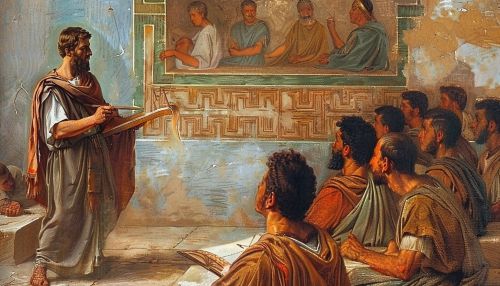History of Geometry: Difference between revisions
(Created page with "== Introduction == Geometry is one of the oldest branches of mathematics, concerned with the properties and relations of points, lines, surfaces, and solids. Its history spans thousands of years and encompasses numerous cultures and civilizations. This article delves into the comprehensive history of geometry, tracing its development from ancient to modern times. == Ancient Geometry == === Egyptian Geometry === The earliest known use of geometry dates back to ancient Eg...") |
No edit summary |
||
| Line 12: | Line 12: | ||
Greek geometry is perhaps the most well-documented and influential in the history of geometry. The Greeks transformed geometry into a deductive science. [[Thales of Miletus]] is often credited with introducing geometry to Greece. He is known for Thales' theorem, which states that any angle inscribed in a semicircle is a right angle. | Greek geometry is perhaps the most well-documented and influential in the history of geometry. The Greeks transformed geometry into a deductive science. [[Thales of Miletus]] is often credited with introducing geometry to Greece. He is known for Thales' theorem, which states that any angle inscribed in a semicircle is a right angle. | ||
[[Image:Detail-96051.jpg|thumb|center|An ancient Greek mathematician teaching geometry to his students.|class=only_on_mobile]] | |||
[[Image:Detail-96052.jpg|thumb|center|An ancient Greek mathematician teaching geometry to his students.|class=only_on_desktop]] | |||
==== Euclidean Geometry ==== | ==== Euclidean Geometry ==== | ||
Latest revision as of 03:03, 4 July 2024
Introduction
Geometry is one of the oldest branches of mathematics, concerned with the properties and relations of points, lines, surfaces, and solids. Its history spans thousands of years and encompasses numerous cultures and civilizations. This article delves into the comprehensive history of geometry, tracing its development from ancient to modern times.
Ancient Geometry
Egyptian Geometry
The earliest known use of geometry dates back to ancient Egypt around 3000 BCE. The Egyptians used geometry in practical ways, such as in the construction of pyramids and the surveying of land. The Rhind Mathematical Papyrus and the Moscow Mathematical Papyrus are some of the oldest mathematical texts that provide insights into Egyptian geometry. These documents contain problems related to the calculation of areas and volumes, demonstrating the Egyptians' understanding of basic geometric principles.
Babylonian Geometry
Around the same time, the Babylonians also made significant contributions to geometry. They developed a sophisticated number system and were able to solve quadratic equations, which are essential in geometric calculations. The Plimpton 322 tablet, dating back to around 1800 BCE, shows that the Babylonians had knowledge of the Pythagorean theorem long before Pythagoras.
Greek Geometry
Greek geometry is perhaps the most well-documented and influential in the history of geometry. The Greeks transformed geometry into a deductive science. Thales of Miletus is often credited with introducing geometry to Greece. He is known for Thales' theorem, which states that any angle inscribed in a semicircle is a right angle.


Euclidean Geometry
The most significant figure in Greek geometry is Euclid, often referred to as the "Father of Geometry." His work, "Elements," is one of the most influential works in the history of mathematics. It systematically presents the principles of geometry, starting from definitions, postulates, and axioms, and builds up to more complex theorems. Euclidean geometry, based on Euclid's postulates, deals with the properties and relations of points, lines, and planes in a flat, two-dimensional space.
Non-Euclidean Geometry
While Euclidean geometry dominated for centuries, the 19th century saw the development of non-Euclidean geometry. Mathematicians such as Nikolai Lobachevsky and János Bolyai independently developed hyperbolic geometry, which negates Euclid's parallel postulate. Bernhard Riemann later developed elliptic geometry, further expanding the understanding of geometric spaces.
Medieval and Islamic Contributions
During the medieval period, Islamic mathematicians made significant advancements in geometry. Scholars such as Al-Khwarizmi and Omar Khayyam translated and expanded upon Greek works, preserving and enhancing geometric knowledge. They developed algebraic methods to solve geometric problems, which laid the groundwork for the later development of algebraic geometry.
Renaissance and Early Modern Geometry
The Renaissance period saw a revival of interest in classical Greek geometry, along with new developments. Leonardo da Vinci and Albrecht Dürer applied geometric principles to art and architecture. René Descartes introduced the concept of coordinate geometry, which allowed geometric problems to be solved algebraically. This was a significant shift, as it bridged the gap between algebra and geometry.
Modern Geometry
Projective Geometry
Projective geometry, developed in the 17th century, studies properties that remain invariant under projection. Girard Desargues and Blaise Pascal were pioneers in this field. Projective geometry has applications in computer graphics, art, and architecture.
Differential Geometry
Differential geometry, which uses calculus and algebra to study geometric problems, was developed in the 18th and 19th centuries. Carl Friedrich Gauss and Bernhard Riemann made significant contributions to this field. Differential geometry is essential in the theory of General Relativity, where it is used to describe the curvature of spacetime.
Topology
Topology, often referred to as "rubber-sheet geometry," studies properties that remain unchanged under continuous deformations. Henri Poincaré is considered the father of topology. This field has profound implications in various areas of mathematics and science, including quantum physics and cosmology.
Contemporary Geometry
In the 20th and 21st centuries, geometry has continued to evolve. Modern geometric research includes areas such as algebraic geometry, which studies solutions to algebraic equations and their geometric properties, and computational geometry, which focuses on algorithms for solving geometric problems. The interplay between geometry and other fields, such as string theory and cryptography, highlights the ongoing relevance and importance of geometric research.
